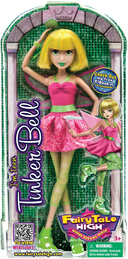In round two of what one person (me) dubbed the "Tinker Bell Fairy Fracas," the CAFC affirmed the Board's decision [TTABlogged here] sustaining a Section 2(d) opposition to registration of TEEN TINKER BELL and TEEN TINK & Design for dolls. The Board found confusion likely with Disney's registered mark TINKER BELL for a variety of goods, including dolls, doll accessories, doll clothes, and doll playsets. United Trademark Holdings, Inc. v. Disney Enterprises, Inc., 2022 USPQ2d XXX (Fed. Cir. 2022) [not precedential].
"Tinker Bell" appeared as a character in J.M. Barrie's Peter Pan, first staged in 1904, and so the parties were in agreement that under copyright law, both the name and the character are in the public domain. In 1939, Disney acquired exclusive rights to produce an animated version of the work and to engage in related merchandising activities. It has used TINKER BELL as a trademark for dolls since 2007 and registered the mark in 2009 without a Section 2(f) acquired distinctiveness claim.
Appellant United challenged the Board's findings on the strength of Disney's mark and the similarity of the involved marks. The CAFC, however, found that substantial evidence supported the Board's factual findings, and it saw no basis for drawing a different legal conclusion with respect to the likelihood of confusion.
United did not seek cancellation of Disney's registration via counterclaim, and so the best it could do was to show that TINKER BELL is highly suggestive of dolls that depict the character. The Board found that the mark's commercial strength overcame any conceptual weakness. The supporting evidence was sufficiently substantial, and so the CAFC affirmed the Board's conclusion that the TINKER BELL mark merited an "ordinary scope of protection."

The CAFC ruled that it was "reasonable" for the Board to find the marks TINKER BELL and TEEN TINKER BELL to be similar in sound and appearance, and likewise similar in connotation and commercial impression.
As the Board noted, United provided no evidentiary support for its theory that Disney's TINKER BELL mark evokes for consumers the public domain Tinker Bell character, instead of the version associated with Disney for decades. *** As a result, it was reasonable for the Board to conclude that both United's and Disney's marks would connote Disney's version of the Tinker Bell character, with United's mark connoting Disney's Tinker Bell character specifically in her adolescent years.
With regard to the TEEN TINK word-plus-design mark, the Board "permissibly determined that the addition of TEEN does not significantly alter the appearance, sound, connotation, and commercial impression of United's mark as compared to Disney's mark." Likewise, the contraction of TINKER BELL to TINK did not effect a material change, since "Tink" has been "commonly used as a nickname for Tinker Bell in Barrie's works." The crown in United's mark "did not call for a different result" because "it is small and less significant than the verbal portions of the mark, working to 'essentially creat[e] a frame for the wording and draw[] additional attention thereto.'"
Read comments and post your comment here.
TTABlogger comment: I am of the view that "Tinker Bell" and other public domain character names are generic for dolls depicting the characters. The dolls themselves are protectable by copyright and/or design patent, but their names should be free to use as long as the source is distinguished.
The content of this article is intended to provide a general guide to the subject matter. Specialist advice should be sought about your specific circumstances.


